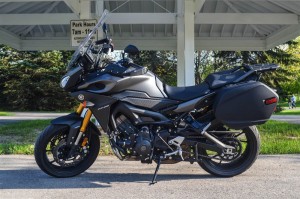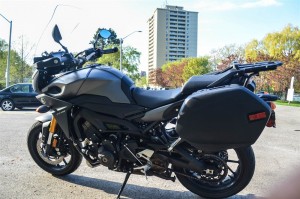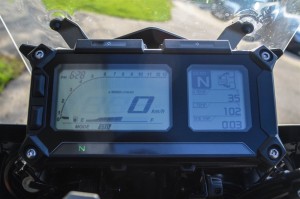Years before the FZ-09 emerged and sensationalized the naked sport category, Yamaha was working hard on the development of the FJ-09, a sport-tourer with the heart of a lion. It seems as if the FZ-09 was strategically released a year earlier than this 2015 Yamaha FJ-09 to lure everyone into falling in love with the 847cc inline triple that graces both bikes. This powerful engine was improved and well-adapted to fit the personality of a beefy, versatile sport-touring machine. The only true change in the engine was a slight blurring of the throttle response, cutting off some of the initial bite of the throttle and allowing for smoother delivery.
Power delivery on the FJ-09 is smooth and simple. The three throttle-response modes of the FJ-09 are also reminiscent of the FZ: A, STD, and B, decreasing in torque from the left. Keeping that in mind, traction control is introduced as a standard feature on the FJ-09, which acts as a sort of sentinel and keeps all of these modes in check. When in neutral, it can be disabled, unleashing the wheelie machine that 2014 FZ-09 is. On a side note, Yamaha stated that the throttle from the 2014 FZ-09 has been fixed and is much smoother on the 2015 model.
Shifting on this new sport-touring is effortless and offers the perfect balance of click and swish. Neutral was always easy to find, a task I find a lot of newer bikes struggle with. The bike redlines at 11.5k rpm, yet this is actually not indicated on the linear tachometer on the LCD dash, which I found surprising. I had to wring out the throttle in first gear to discover the redline. Nevertheless, as the powerband hovers around the 6-9000rpm range, it is not really necessary to touch redline. Apart from this slight fault in the LCD dash, the display is comprehensive, intuitive, and informative. The right side of the display is highly customizable in terms of statistics and metrics, well-geared towards long-distance travel. To the left of the display is a DC outlet, optimal for a GPS, which could easily be mounted to the 18L fuel tank of the FJ-09.
When I first saw my tester, its edgy design reminded me quite heavily of a wasp in the most alluring way possible. Even on the side of the tank, a honeycomb-like design is visible. The windscreen, though, was slightly off-putting. It looked a little goofy, and in the saddle, the top edge of it landed directly at eye-level, which I thought would be cumbersome. On the contrary, the windscreen is one of the aspects of it that truly makes it such a phenomenal sport-touring machine.
Needing nothing but my hands and the ability to twist a knob, I slid the shield about 0.5 inches of its 1.2 inch range upwards. At highway speeds, rolling smooth in sixth gear, the windscreen directs all the wind about an inch above my head. Though there was minor head-rocking, wind noise was immensely decreased and my chest was nearly untouched by strong winds. Handguards also come standard on the FJ-09, which were a blessing on the cold Canadian summer days I was riding. That being said, on a particularly windy day, I did experience some high-speed wobble, which was quickly corrected by slowing down and shifting up to a higher gear.
Speaking more to its sport-touring aspects, the suspension of the FJ-09, though utilizing the same components as the FZ-09, has been adjusted to accommodate for heavier loads and generally lower-intensity riding. A softer initial travel in the suspension made riding over the cracks of winter all the more bearable. The saddle has been manipulated as well, featuring incredible padding and more girth. The seat is 33.3 inches tall, up from the 32.1 inch seat of the FZ-09. The handlebar has also been brought further upwards by 0.9 inches, relaxing the body position for long rides. By the way, if the handlebar is still too far forward, you can rotate the riser 180 degrees, moving the bar 0.4 inches closer to the saddle. All-in-all, the ergonomics of the bike, still drawing its inspiration from motocross, are way above average.
The FJ-09 also has plenty of room for luggage. The sturdy metal plate on the back of the bike reads a maximum load of 5kg, which, combined with spacious saddlebags, would be more than plenty for a camping trip or a week-long journey. Unfortunately, the saddlebags cannot fit a full-face helmet. Another key aspect of the FJ-09 that makes it an incredible road trip machine is the presence of a centre-stand, allowing for maintenance work on the go.
The 2015 FJ-09 comes in at $10,999. Yamaha is entering new grounds here, competing with bikes such as the Honda VFR800F, the Suzuki V-Strom 1000, and the Aprilia Mana 850 GT. The FJ-09’s price is astonishingly low for the impressive quality of the vehicle, and I wouldn’t hesitate in choosing it as my motorcycle of choice for a two-week road trip.
2015 Yamaha FJ-09 Gallery





















